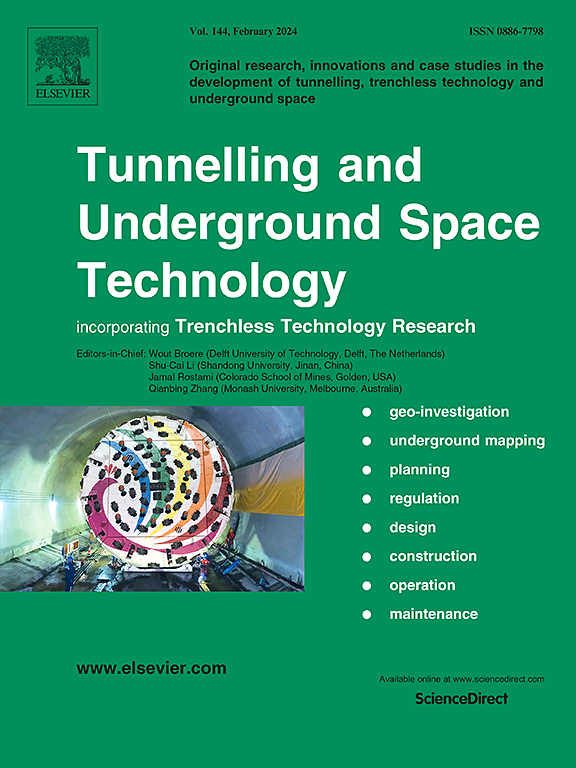Transitioning to zero emission construction: A comparative study of diesel and electric loaders and trucks in Norwegian tunnel construction
IF 7.4
1区 工程技术
Q1 CONSTRUCTION & BUILDING TECHNOLOGY
引用次数: 0
Abstract
The construction industry is progressively seeking sustainable solutions to mitigate environmental impacts, particularly in the realm of heavy machinery operations. This study conducts a comprehensive comparative analysis between diesel and electric loaders and trucks in the context of tunnel construction, with a specific focus on transitioning to zero-emission practices. Analyzing data from 30 years of excavation projects in standard Norwegian roadway tunnels during drill and blast tunneling, the study evaluates environmental impacts, including carbon emissions, ozone depletion, particulate matter formation, and ecotoxicity and human toxicity potentials using life cycle assessment methodologies. Comparing diesel-powered machinery to battery-powered machinery for tunnel lengths ranging from 500 m to 5 km reveals that battery-powered equipment achieves significant environmental benefits, with reductions of 83 % and 80 % in global warming potential, 75 % and 73 % in ozone depletion potential, 81 % and 76 % in particulate matter formation, and 76 % and 71 % in terrestrial acidification potential, respectively. However, the use of battery engines results in a notable increase in toxicity potentials, with terrestrial eco-toxicity values rising approximately 10-fold to 11-fold and human toxicity increasing by 6 % to 7 % compared to internal combustion engine machines, spanning tunnel lengths from 0.5 to 5 km. This highlights a trade-off in the adoption of electrification, where CO2 emissions are reduced but terrestrial eco-toxicity is increased. As tunnel length increases, transportation emissions surpass loading emissions due to increased transportation activities and improved loading efficiency. Thus, this research underscores the benefits of electrification for emission reduction and sustainability, offering valuable insights for policymakers seeking zero-emission construction practices aligned with Norway’s carbon neutrality commitment.

向零排放施工过渡:挪威隧道施工中柴油和电动装载机和卡车的比较研究
建筑行业正在逐步寻求可持续的解决方案,以减轻对环境的影响,特别是在重型机械操作领域。本研究对隧道施工中的柴油装载机和电动装载机以及卡车进行了全面的比较分析,并特别关注向零排放实践的过渡。该研究分析了30年来挪威标准巷道隧道在钻孔和爆破掘进过程中的挖掘项目数据,利用生命周期评估方法评估了环境影响,包括碳排放、臭氧消耗、颗粒物形成、生态毒性和人类毒性潜力。在500米至5公里的隧道长度范围内,将柴油动力机械与电池动力机械进行比较,发现电池动力设备具有显著的环境效益,全球变暖潜势分别降低83%和80%,臭氧消耗潜势分别降低75%和73%,颗粒物形成分别降低81%和76%,陆地酸化潜势分别降低76%和71%。然而,电池发动机的使用导致毒性潜力显著增加,与内燃机机器相比,陆地生态毒性值上升约10至11倍,人体毒性增加6%至7%,隧道长度从0.5至5公里不等。这突出了采用电气化的权衡,减少了二氧化碳排放,但增加了陆地生态毒性。随着隧道长度的增加,由于运输活动的增加和装载效率的提高,运输排放超过装载排放。因此,这项研究强调了电气化对减排和可持续性的好处,为寻求零排放建筑实践的政策制定者提供了有价值的见解,这些实践符合挪威的碳中和承诺。
本文章由计算机程序翻译,如有差异,请以英文原文为准。
求助全文
约1分钟内获得全文
求助全文
来源期刊

Tunnelling and Underground Space Technology
工程技术-工程:土木
CiteScore
11.90
自引率
18.80%
发文量
454
审稿时长
10.8 months
期刊介绍:
Tunnelling and Underground Space Technology is an international journal which publishes authoritative articles encompassing the development of innovative uses of underground space and the results of high quality research into improved, more cost-effective techniques for the planning, geo-investigation, design, construction, operation and maintenance of underground and earth-sheltered structures. The journal provides an effective vehicle for the improved worldwide exchange of information on developments in underground technology - and the experience gained from its use - and is strongly committed to publishing papers on the interdisciplinary aspects of creating, planning, and regulating underground space.
 求助内容:
求助内容: 应助结果提醒方式:
应助结果提醒方式:


